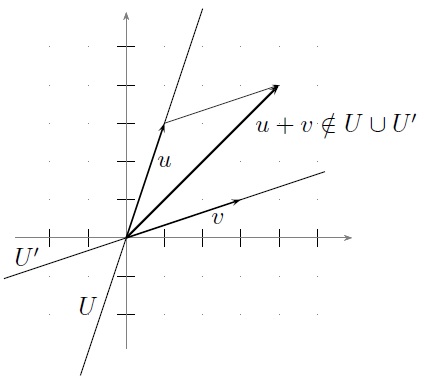4.4: Sums and direct sum
( \newcommand{\kernel}{\mathrm{null}\,}\)
Throughout this section, V is a vector space over F, and U1,U2⊂V denote subspaces.
Definition 4.4.1: (subspace) sum
Let U1,U2⊂V be subspaces of V . Define the (subspace) sum of U1

Figure 4.4.1: The union U∪U′ of two subspaces is not necessarily a subspace.
and U2 to be the set
U1+U2={u1+u2|u1∈U1,u2∈U2}.
Check as an exercise that U1+U2 is a subspace of V . In fact, U1+U2 is the smallest subspace of V that contains both U1 and U2 .
Example 4.4.2. Let
U1={(x,0,0)∈F3|x∈F},U2={(0,y,0)∈F3|y∈F}.
Then
U1+U2={(x,y,0)∈F3|x,y∈F}.
If, alternatively, U2={(y,y,0)∈F3|y∈F}, then Equation (4.4.2) still holds.
If U=U1+U2 , then, for any u∈U, there exist u1∈U1 and u2∈U2 such that u=u1+u2.
If it so happens that u can be uniquely written as u1+u2 , then U is called the direct sum of U1 and U2.
Definition 4.4.3: Direct Sum
Suppose every u∈U can be uniquely written as u=u1+u2 for u1∈U1 and u2∈U2 . Then we use
U=U1⊕U2
to denote the direct sum of U1 and U2.
Example 4.4.4. Let
U1={(x,y,0)∈R3|x,y∈R},U2={(0,0,z)∈R3|z∈R}.
Then R3=U1⊕U2. However, if instead
U2={(0,w,z)|w,z∈R},
then R3=U1+U2 but is not the direct sum of U1 and U2 .
Example 4.4.5. Let
U1={p∈F[z]|p(z)=a0+a2z2+⋯+a2mz2m},U2={p∈F[z]|p(z)=a1z+a3z3+⋯+a2m+1z2m+1}.
Then F[z]=U1⊕U2.
Proposition 4.4.6. Let U1,U2⊂V be subspaces. Then V=U1⊕U2 if and only if the following two conditions hold:
- V=U1+U2;
- If 0=u1+u2 with u1∈U1 and u2∈U2 , then u1=u2=0.
Proof.
(“⇒”) Suppose V=U1⊕U2. Then Condition 1 holds by definition. Certainly 0=0+0, and, since by uniqueness this is the only way to write 0∈V , we have u1=u2=0.
(“⇐”) Suppose Conditions 1 and 2 hold. By Condition 1, we have that, for all v∈V , there exist u1∈U1 and u2∈U2 such that v=u1+u2 . Suppose v=w1+w2 with w1∈U1 and w2∈U2 . Subtracting the two equations, we obtain
0=(u1−w1)+(u2−w2),
where u1−w1∈U1 and u2−w2∈U2. By Condition 2, this implies u1−w1=0 and u2−w2=0, or equivalently u1=w1 and u2=w2 , as desired.
Proposition 4.4.7. Let U1,U2⊂V be subspaces. Then V=U1⊕U2 if and only if the following two conditions hold:
- V=U1+U2;
- U1∩U2={0}.
Proof.
(“⇒”) Suppose V=U1⊕U2. Then Condition 1 holds by definition. If u∈U1∩U2 , then 0=u+(−u) with u∈U1 and −u∈U2 (why?). By Proposition 4.4.6, we have u=0 and −u=0 so that U1∩U2={0}.
(“⇐”) Suppose Conditions 1 and 2 hold. To prove that V=U1⊕U2 holds, suppose that
0=u1+u2, where u1∈U1 and u2∈U2.
By Proposition 4.4.6, it suffices to show that u1=u2=0. Equation (4.3) implies that u1=−u2∈U2. Hence u1∈U1∩U2, which in turn implies that u1=0. It then follows that u2=0 as well.
Everything in this section can be generalized to m subspaces U1,U2,…Um, with the notable exception of Proposition 4.4.7. To see, this consider the following example.
Example 4.4.8. Let
U1={(x,y,0)∈F3|x,y∈F},U2={(0,0,z)∈F3|z∈F},U3={(0,y,y)∈F3|y∈F}.
Then certainly F3=U1+U2+U3 , but F3≠U1⊕U2⊕U3 since, for example,
(0,0,0)=(0,1,0)+(0,0,1)+(0,−1,−1).
But U1∩U2=U1∩U3=U2∩U3={0} so that the analog of Proposition 4.4.7 does not hold.
Contributors
- Isaiah Lankham, Mathematics Department at UC Davis
- Bruno Nachtergaele, Mathematics Department at UC Davis
- Anne Schilling, Mathematics Department at UC Davis
Both hardbound and softbound versions of this textbook are available online at WorldScientific.com.


